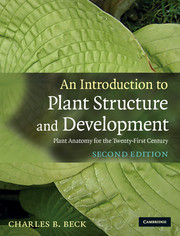Book contents
- Frontmatter
- Contents
- Preface to the second edition
- Preface
- Acknowledgements
- General references
- Chapter 1 Problems of adaptation to a terrestrial environment
- Chapter 2 An overview of plant structure and development
- Chapter 3 The protoplast of the eukaryotic cell
- Chapter 4 Structure and development of the cell wall
- Chapter 5 Meristems of the shoot and their role in plant growth and development
- Chapter 6 Morphology and development of the primary vascular system of the stem
- Chapter 7 Sympodial systems and patterns of nodal anatomy
- Chapter 8 The epidermis
- Chapter 9 The origin of secondary tissue systems and the effect of their formation on the primary body in seed plants
- Chapter 10 The vascular cambium: structure and function
- Chapter 11 Secondary xylem
- Chapter 12 The phloem
- Chapter 13 Periderm, rhytidome, and the nature of bark
- Chapter 14 Unusual features of structure and development in stems and roots
- Chapter 15 Secretion in plants
- Chapter 16 The root
- Chapter 17 The leaf
- Chapter 18 Reproduction and the origin of the sporophyte
- Glossary
- Index
- References
Chapter 7 - Sympodial systems and patterns of nodal anatomy
Published online by Cambridge University Press: 05 June 2012
- Frontmatter
- Contents
- Preface to the second edition
- Preface
- Acknowledgements
- General references
- Chapter 1 Problems of adaptation to a terrestrial environment
- Chapter 2 An overview of plant structure and development
- Chapter 3 The protoplast of the eukaryotic cell
- Chapter 4 Structure and development of the cell wall
- Chapter 5 Meristems of the shoot and their role in plant growth and development
- Chapter 6 Morphology and development of the primary vascular system of the stem
- Chapter 7 Sympodial systems and patterns of nodal anatomy
- Chapter 8 The epidermis
- Chapter 9 The origin of secondary tissue systems and the effect of their formation on the primary body in seed plants
- Chapter 10 The vascular cambium: structure and function
- Chapter 11 Secondary xylem
- Chapter 12 The phloem
- Chapter 13 Periderm, rhytidome, and the nature of bark
- Chapter 14 Unusual features of structure and development in stems and roots
- Chapter 15 Secretion in plants
- Chapter 16 The root
- Chapter 17 The leaf
- Chapter 18 Reproduction and the origin of the sporophyte
- Glossary
- Index
- References
Summary
Perspective: leaf traces
Vegetative shoots consist of stems bearing leaves. In order to develop, and to synthesize various necessary compounds required by the plant, leaves must have access to a source of water and essential minerals which are transported into them from the stem through the primary xylem. Photosynthate and other compounds synthesized in the leaves are, in turn, transported through the primary phloem into the stem and root system for storage and/or use. This transport of substances takes place in primary vascular connections between the stem vascular system and the base of leaves called leaf traces. Traces may diverge from the stem vascular system some distance below, or very near, the nodes (sites of attachment of leaves to stems) at which they enter the leaves. Leaf traces are composed of protoxylem, metaxylem, protophloem, and metaphloem, and typically contain transfer cells in both primary xylem and primary phloem. In seed plants, leaf traces are often larger and contain more tracheary cells than the vascular bundles from which they diverge, and they may increase in size distally. A leaf may be vascularized by only one or by several to many leaf traces.
In order to understand the morphology of nodal regions of shoots we must observe both transverse and median longitudinal sections through these regions. Remember that stems bear many leaves in various spatial distributions.
- Type
- Chapter
- Information
- An Introduction to Plant Structure and DevelopmentPlant Anatomy for the Twenty-First Century, pp. 123 - 140Publisher: Cambridge University PressPrint publication year: 2010
References
- 1
- Cited by



